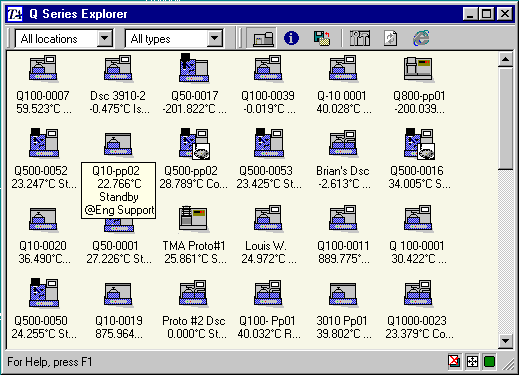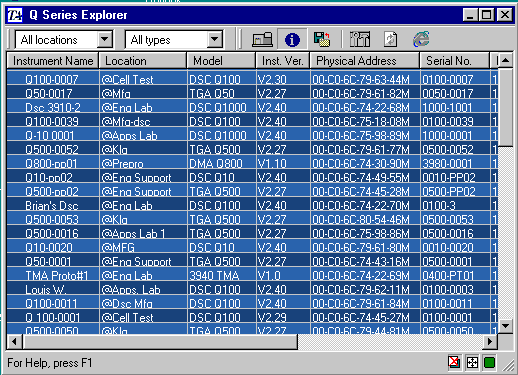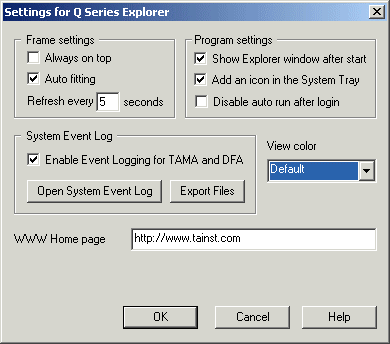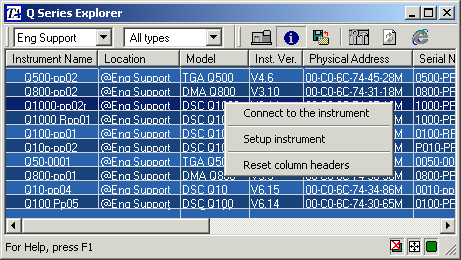 Using the Q Series™
Explorer
Using the Q Series™
Explorer Using the Q Series™
Explorer
Using the Q Series™
Explorer
The Q Series™ Explorer Window is a customizable graphical user interface for TA Messaging Agent (TAMA). It enables users to setup, view and control any instruments currently connected to the supplied private Ethernet switch or a Local Area Network (LAN). The Q Series™ Explorer is also used to monitor the status of data transmission from the instrument to any controller via the Data File Acceptor (DFA).
To open the Q Series Explorer, double click on the ![]() icon
located on your desktop to start the program.
icon
located on your desktop to start the program.
Click on the following topics for more information:
To change the language displayed for the Q Series Explorer and Instrument Control program follow these steps:
Click the icon in the upper left-hand corner of the Q Series Explorer window to display the drop-down menu.
Choose Select Language, then
select one of the three available languages, English,
Deutsch (German),
 (Japanese),
(Japanese),
 (Chinese).
After you select the language, the program will automatically be displayed
in the chosen language.
(Chinese).
After you select the language, the program will automatically be displayed
in the chosen language.
Repeat the process to change the language again.
The language used for instrument control is based on the instrument language. To set this language see Updating Instrument Software and Downloading the Language Files.
The Q Series Explorer is used to perform the following functions:
Double click on the instrument
icon (e.g., ![]() )
on the Online Instrument view to connect to a selected instrument and
automatically open the instrument control software for that instrument.
)
on the Online Instrument view to connect to a selected instrument and
automatically open the instrument control software for that instrument.
Right click on the instrument
icon (e.g., ![]() )
on the Online Instrument view or right click on an instrument row in the
Instrument Information View to connect to the instrument using the pop-up
menu.
)
on the Online Instrument view or right click on an instrument row in the
Instrument Information View to connect to the instrument using the pop-up
menu.
Right click on the instrument
icon (e.g., ![]() )
on the Online Instrument view
and select Setup
Instrument to make changes to the instrument settings such as:
synchronize the instruments and PC’s date and time, updating module software,
resetting the instruments parameters, and configuring the instrument's
network settings.
)
on the Online Instrument view
and select Setup
Instrument to make changes to the instrument settings such as:
synchronize the instruments and PC’s date and time, updating module software,
resetting the instruments parameters, and configuring the instrument's
network settings.
Click the various icons on the Q Series™ Explorer tool bar to view the status of each instrument, any error information associated with that instrument, or the data file acceptor (DFA) status.
Access the drop-down menu (from the upper left corner icon) and the right click pop-up menu to perform various functions.











The Q Series™ Explorer tool bar is used to access various functions associated with the Explorer window and the instruments online. Click on the name of the item below for more information.
This button is used to view all the instruments currently online. This window displays the Name, Temperature, State and Location for each instrument currently connected to the private Ethernet Hub or LAN.

This button is used to view instrument information. This window displays the Instrument's Name, Location, Model, current version of instrument software installed (Inst. Ver.), Physical Address, Serial No., IP Address, Update Time (and Date), name of controller computer (Master Name), Installed Options, and the number of connections (NOC) for each instrument connected to the private Ethernet Hub or LAN.

 Viewing
the Data File Acceptor (DFA) Status
Viewing
the Data File Acceptor (DFA) Status
Click this button to view the Data File Acceptor (DFA) Status for all instruments. This window displays the status of data transmission from the instrument to the controller as well as the Instrument Name, Number of Bytes Received, Data File Acceptor (DFA) State, Time and Date Information Last Updated, IP Address, and the Data File Path for each instrument connected to the private Ethernet Hub or LAN.
 Changing
the Q Series™
Explorer Settings
Changing
the Q Series™
Explorer Settings
This button is used to view the settings for the Q Series Explorer. This window allows you to customize the appearance of the Q Series Explorer based on the options selected. The list of options and their functions are listed below. See Changing the Q Series Explorer Settings.
 Refreshing
the Q Series™
Explorer
Refreshing
the Q Series™
Explorer
Click this button to immediately refresh all of the information displayed in the Q Series Explorer.
This button is used to connect to the specified Internet Home Page address
that was set using the
Q Series
Explorer Settings  .
.
Use the two drop-down menus to sort the instruments connected online based on location or instrument type in the Q Series Explorer. To display all of the instruments, select All Locations or All Types.
Click the  button on the Q Series™
Explorer tool bar to view the settings for the Q Series™
Explorer as shown below:
button on the Q Series™
Explorer tool bar to view the settings for the Q Series™
Explorer as shown below:

Follow these instructions to set up the Explorer window.
Check Always on Top, if you want the instrument Explorer window to be displayed on top of any other open window. If left unchecked, the window will be displayed in the regular fashion.
Check Auto Fitting, if you want the items displayed on the instrument Explorer window to be sized so that they will fit into the area of the currently displayed window.
Enter the desired refresh time in the Refresh every ___ seconds field, which is the time that will elapse before the Q Series™ Explorer window is updated again with new information.
Check Show Explorer window after start to automatically display the Q Series™ Explorer window every time your computer is started.
Check Add an icon in the System Tray to automatically add an icon for the Explorer to the system tray when the window is open
Check Disable auto run after login to keep the Explorer from running after logging on to Microsoft Windows.
Check Enable Event Logging for TAMA and DFA to enable the logging of TAMA and DFA messages in the event log.
Click the Open System Event Log button to open the System Event Log. This log contains information about hardware, software and system problems.
Click the Export Files button to export the Event and Application Logs to the desktop.
Select a color from the View Color drop-down list to change the background color of the Explorer window.
Enter a default WWW Home page address for the Internet icon on the tool bar.
Click OK when completed.
To access the Q Series™
Explorer Pop-up menu, right click on the instrument icon (e.g.,
![]() ) in the Online Instrument View or right click on an instrument
row in the Instrument Information View as shown in the figure below.
) in the Online Instrument View or right click on an instrument
row in the Instrument Information View as shown in the figure below.

Select from one of the following menu options. Click on the name for further information.
Select Connect to the instrument to connect the selected (highlighted) instrument to your computer and automatically open instrument control software for that instrument.
Select Setup Instrument to make changes to the instrument settings for the selected (highlighted) instrument. This will open the Instrument Setup Wizard dialog that can be used to synchronize the instruments and PC’s Date and Time, Update Module Software, Reset the Instruments Parameters, and Configure the Instruments Network Settings.
Select Reset column headers to reset the columns and their headers to the default positions. This feature is helpful if the columns have been repositioned and no longer display as desired.
To access the Q Series™ Explorer drop-down menu, click on the icon located in the upper left-hand corner of the window. Select from the following menu options. Click on the name for more information on that item.
Used to reset the Q Series Explorer window to its previous size and/or position.
Used to reposition the Q Series Explorer window. A four-sided arrow is displayed when this function is selected. Hold down the left mouse button and drag the window to the desired position, then release the button.
Used to resize the Q Series Explorer window. A four-sided arrow is displayed when this function is selected. Move your pointer to any edge or corner of the TA Instrument Explorer window. When the four-sided arrow is displayed, hold down the left mouse button and drag the window border until the desired size is reached. Then release the mouse button.
Used to minimize the Q Series Explorer window to a button on the Task bar.
Used to open (maximize) the Q Series Explorer window so that it completely fills the available monitor space.
Used to close the Q Series Explorer window.
Used to hide the Q Series Explorer window from view. You must reopen the window to display it again.
Connect to Remote TA Message Agent (TAMA)
TA Message Agent (TAMA) is a function that operates behind-the-scenes to control various instrument functions. When you select Connect to Remote TA Message Agent (TAMA) from the menu a window is displayed to allow you to change to a remote TAMA.
When you select Show This Computer License from the menu, a window is displayed to allow you to view the user information, unit information, license information, and permissions associated with the computer.
When you select Show Version Information from the menu, a window is displayed to allow you to view the current versions of all of the software components.
Select this menu item to close and restart both the Q Series Explorer and the TA Message Agent (TAMA).
Locate instrument with default IP address
Select Locate instrument with default IP address to find an instrument that has just had its IP address reset to the default IP address 172.23.160.31 and does not appear in the Q Series Explorer. After choosing this menu item a window will be displayed containing instructions that you need to follow.

Select this menu item to display the version number for the Q Series Explorer and the controller identification number for the current controller computer.